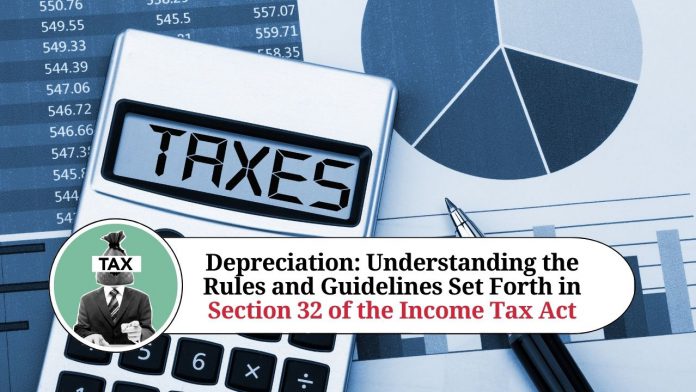Depreciation is an important concept in the field of taxation. It is a measure of the wear and tear of an asset over time and is used to calculate the taxable income of a business or individual. Depreciation is provided by Section 32 of the Income Tax Act. In this blog, we will discuss what depreciation is, how it is calculated, and the different types of depreciation.
What is Depreciation?
Depreciation is a method of allocating the cost of an asset over its useful life. It is the reduction in the value of an asset over time due to wear and tear, obsolescence, or other factors. Depreciation is important because it reflects the true economic value of an asset and helps to determine the taxable income of a business or individual.
Calculation of Depreciation
The amount of depreciation that can be claimed depends on the type of asset, its cost, and its useful life. The Income Tax Act provides a set of rules and guidelines for calculating depreciation.
The formula for calculating depreciation is as follows:
Depreciation = Cost of Asset – Residual Value ÷ Useful Life
Cost of Asset refers to the total amount paid for the asset, including any expenses related to acquiring and installing the asset. Residual Value is the estimated value of the asset at the end of its useful life. Useful Life refers to the period during which the asset is expected to be useful for business purposes.
Types of Depreciation
There are different types of depreciation that can be used to calculate the tax deduction for an asset. The most common types of depreciation are:
- Straight-line Depreciation: This method spreads the cost of the asset evenly over its useful life. The same amount of depreciation is claimed each year.
- Declining Balance Depreciation: This method allows for a higher amount of depreciation in the early years of an asset’s useful life, and a lower amount of depreciation in later years.
- Unit of Production Depreciation: This method calculates depreciation based on the number of units produced by the asset. The more units produced, the higher the depreciation claimed.
While depreciation can be a complex topic, it is a vital concept for businesses and individuals alike. By understanding the principles of depreciation, it is possible to make informed financial decisions that can help minimize tax liabilities.
It’s important to note that while depreciation can help to reduce taxable income, it is not always the best strategy for minimizing tax liabilities. In some cases, it may be more advantageous to claim a deduction for the full cost of the asset in the year it was purchased, rather than spreading the deduction out over several years.
Additionally, there are several factors that can affect the amount of depreciation that can be claimed, including changes in tax laws, changes in accounting methods, and changes in the useful life of an asset. As such, it is important to stay up-to-date with changes in tax laws and accounting standards in order to accurately calculate depreciation and minimize tax liabilities.
Finally, it is important to note that depreciation is just one of many tax deductions and strategies that businesses and individuals can use to minimize their tax liabilities. Other strategies may include charitable donations, business expenses, and retirement contributions.
Conclusion
Depreciation is an important concept in the field of taxation. It reflects the true economic value of an asset and helps to determine the taxable income of a business or individual. Section 32 of the Income Tax Act provides guidelines for calculating depreciation. There are different types of depreciation that can be used to calculate the tax deduction for an asset. It is important for businesses and individuals to understand the rules and guidelines for depreciation in order to accurately calculate their taxable income.
Read more useful content:
- section 145 of income tax act
- section 10e of income tax act
- section 9 of the income tax act
- section 94b of income tax act
- section 206aa of income tax act
Frequently Asked Questions (FAQs)
What is depreciation?
Depreciation is the reduction in the value of an asset over time due to wear and tear, obsolescence, or other factors. It is a method of allocating the cost of an asset over its useful life.
What is the purpose of depreciation?
Depreciation is used to reflect the true economic value of an asset and helps to determine the taxable income of a business or individual. It is an important concept in the field of taxation.
How is depreciation calculated?
Depreciation is calculated using the formula: Depreciation = Cost of Asset – Residual Value ÷ Useful Life. The cost of the asset is the total amount paid for it, residual value is the estimated value at the end of its useful life, and useful life is the period during which the asset is expected to be useful for business purposes.
What are the different types of depreciation?
The most common types of depreciation are straight-line depreciation, declining balance depreciation, and unit of production depreciation.
Can I claim depreciation on all assets?
No, not all assets are eligible for depreciation. Assets that are expected to last less than one year, land, and certain intangible assets are not eligible for depreciation.
Can I claim depreciation on assets that were inherited or gifted?
Yes, inherited or gifted assets can be claimed for depreciation, but the basis for calculating the depreciation will be different than for assets that were purchased.
What happens if I sell an asset before its useful life is up?
If you sell an asset before its useful life is up, you may need to recapture some of the depreciation that you claimed as a taxable gain.
Can I claim depreciation for assets that are no longer in use?
No, assets that are no longer in use are not eligible for depreciation.
How often do I need to recalculate depreciation?
Depreciation calculations should be reviewed regularly, especially if there are changes in tax laws, accounting methods, or the useful life of an asset.
What are some other tax strategies that can be used in addition to depreciation?
Other tax strategies may include charitable donations, business expenses, and retirement contributions. It’s important to work with a tax professional to determine the best tax strategies for your individual situation.




















